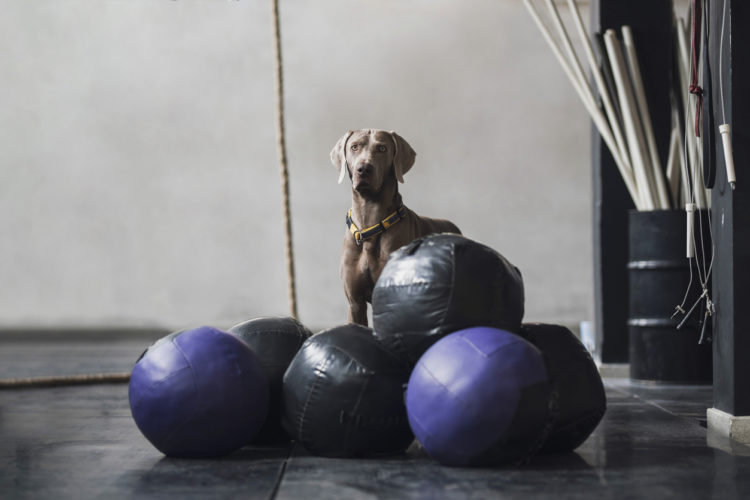BY STACEY PENNEY, MS, NASM-CPT, CES, PES, FNS
Bringing your pet dog to work, or anywhere for that matter, seems to have become the norm. But what about the fitness realm? Have you thought about bringing your dog to the gym or to a workout with you? Some locals have their own four-legged (or three-legged!) gym mascot that greets the clients, or clients themselves might bring their own leashed exercise partner to a session. Below we’ll take a surface look at the benefits and a few precautions of adding a dog to the exercise equation. Please note that this is looking at “pets” versus the unique aspects of service and therapy dogs.
I’m sure many of you have seen social posts of local studios with their dogs or even programs, such as K9 Fit Club, that focus on working out with your dog. Two of the four fitness businesses I go to frequently have dogs on site. Some research highlights that dogs can help bring a sense of well-being and other potential health benefits, including: 1,2,3
- Increased physical activity (e.g., more walking)
- Reduced risk of cardiovascular disease
- Lowers stress (e.g., anxiety, blood pressure, relaxation)
- Social support
- Companionship
- Improved performance on various tasks
*Note: There have been challenges with study replication and also some studies indicating no differences or conflicting results between pet and non-pet owners.3
Dogs can also be helpful in improving the social interactions within the community that studios and personal trainers aim to foster among members.2
A tail-wagging greeting, a friendly non-judging nuzzle, a playful nudge during a warmup can all put a smile on a client’s face and help to dissolve the tension of the day. But this may not be the case for all clients, or even members of your training team. Some may have allergies, fears or phobias of dogs. They may not want to workout with a dog on site or have a less than positive response to dog hair and dander (which just seems to magnetically attach to athletic apparel).
Here’s some small bites (pun intended) to consider for canine gym participation.
Do you have a dog policy in place? We’re not offering legal advice, but formalizing your dog policy – and having it reviewed by a qualified person (insurance, legal or other) – makes good business sense. This policy applies to your team staff and the clients who might bring a dog to the site.
What does your liability insurance policy cover in regards to animals on site? Some potential incidents to consider would include trip and fall situations, property damage or even bites. After speaking with a fitness industry liability insurance provider, we discovered that their general liability policies do not cover animal-related incidents. Exploring other posted information sources on the topic, responsibility for an incident typically resides with the dog’s owner (and their homeowner’s insurance policy) but each state, and situation, can have different laws and considerations.2
Is the dog well mannered? There are various tests to make sure your dog, or a client’s dog, are well mannered and are candidates for participation. Ask your veterinarian or insurance provider for their recommendations or who they accept. One source is the American Kennel Club (AKC) and their Canine Good Citizen test. It includes these 10 key items that are scored by an AKC CGC® Approved Evaluator:
- Accepting a friendly stranger
- Sitting politely for petting
- Appearance and grooming
- Out for a walk
- Walking through a crowd
- Sit and down on command, and staying in place
- Coming when called
- Reaction to another dog
- Reaction to distraction
- Supervised separation
Will the dog’s owner/client need to sign a release to participate? Will they need to show proof of insurance and that they are well mannered?
Is there a limit as to how many dogs are allowed on site at once? Is there a safe place for dogs to wait while their owner’s workout? Dog owner responsibilities-yes, the clean up after your dog mantra- but also a designation for where to dispose of the present so it doesn’t linger in the gym air and things stay clean.
What will you do if a client complains about a dog (any dog) or not wanting to workout with a dog on site?
So where do you stand, or sit, on the topic of dogs at the gym? What insightful exercise experiences have you had with canine partners that might help others decide?

